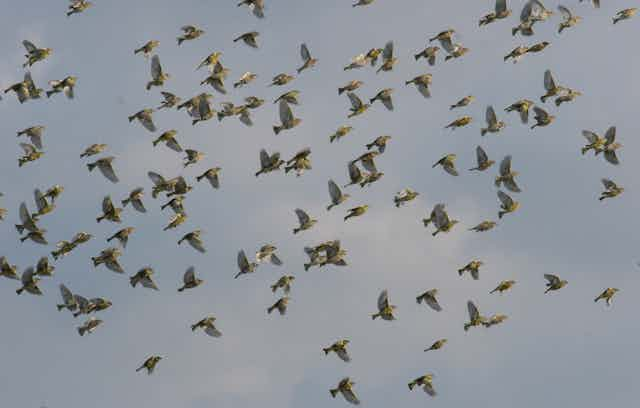Animals have a habit of moving. Sometimes these movements are truly epic. Migratory birds regularly traverse the globe between temperate and tropical regions, a feat that would require considerable pharmaceutical protection from disease if you or I were to attempt it.
For example, Afro-Palaearctic migratory birds travel thousands of kilometres twice a year between their wintering grounds in tropical Africa and their European breeding grounds. Other relocations may be more permanent, such as when species colonise new regions. As they migrate or colonise new areas, they are exposed to entirely new communities of pathogens – disease causing agents, such as bacteria and viruses. But what effect do these incredible journeys have on their immune system?
In our new study, my colleagues and I set out to map the origin of European and African songbirds, to see how their immune systems have developed as they colonised new areas and began to migrate. What we found was surprising: European and migratory songbirds both came from Africa. And this migration and colonisation of new habitats changed their immune systems in a way that suggests they no longer need to worry about African pathogens.
Scientists have long argued about the direction of colonisation routes between Europe and Africa – did European birds come from Africa, or did African birds come from Europe? To answer this, we reconstructed the past distributions of over 1,300 African and European songbirds over the past 45m years based upon where they live now and how they are related, their genealogy.
The birds we studied fall into two main groups: species that live all year-round in either Africa or Europe (residents), and species that migrate to breed in Europe and spend their winters in Africa (migrants). We saw that resident European songbirds have African ancestors, indicating that colonisation occurred out of Africa and into Europe. Similarly, migratory species also have African ancestry, suggesting that migration evolved as African species shifted their breeding ranges into Europe.
Use it or lose it immunity
The out-of-Africa direction of movement in both migratory and resident songbirds means that these species moved from regions of high to low pathogens, because there are more pathogens closer to the equator. To see how this reduction in pressure from pathogens affected the immune systems of these species, we looked at a subset of birds and examined their genetic profiles.
We focused on genes involved in pathogen recognition, known as the major histocompatibility complex (MHC) genes, which are vital in getting the immune system to respond to threats. The higher the diversity of MHC genes an individual has, the more pathogens they can potentially recognise.

We compared the resident European birds (which had migrated out of Africa and colonised Europe) with the resident African birds, to see if there were any differences in the diversity of their MHC genes. As expected, we found that the species that left Africa had a less diverse set of immunity genes.
In other words, evolution has seen to it that species have the immune system that they need, and complexity in the immune system is lost if the birds move to an area with fewer pathogens. One reason for this loss of complexity may be that an unnecessarily complex immune system could be an evolutionary disadvantage, since it may increase the risk of damage from misdirected immune responses, for example through auto-immune diseases.
But what about the migratory birds? These are an interesting case, as they breed in Europe, but spend most of the year in pathogen-rich Africa. These birds have to deal with the pathogens present in both Europe and Africa. We expected these migratory species to have the most diverse set of immunity genes of all the species we examined.
Surprisingly, this was not the case. Migrants had similar MHC diversity to that of European species. That is to say, migrants actually had less diverse immunity genes than species that live all year in Africa.

So what is going on? As I mentioned earlier, the migratory birds leave Africa for Europe to breed. In doing so, they appear to escape pathogens. This shows that the breeding season is a particularly formative period for the development of the immune system in these birds.
Perhaps this is because when they are breeding they are especially vulnerable to pathogens as their resources are diverted to reproduction. Another possibility is that this is when they encounter many pathogens for the first time (as chicks), making it an influential phase for the immune system. Either way, breeding in Europe as opposed to Africa, appears to have significantly reduced the number of pathogens these birds have to cope with.
Insights into vertebrate immunity
The results of our study show that living in areas with fewer pathogens can, over evolutionary time, lead to a reduction in the complexity of the immune system. This matters because all vertebrates, including birds and humans, share common features in their immune systems. In other words, the more we know about the factors that shape vertebrate immunity in general, the better we will understand our own immune system and the patterns of biodiversity that we see around the world today.
So what else might birds be able to tell us about the evolution of immune systems? Interestingly, New World songbirds are believed to have colonised the Neotropics (tropical areas of North, Central and South America) from the north – the exact opposite of what we see in Africa and Europe. It seems that these birds migrated towards pathogens.
It would be fascinating to see whether this has resulted in the opposite pattern in their immune systems, whereby birds in North America have more complex immune systems than those at the tropics. This is the next question for us to answer and will no doubt be the topic of future research.
This article is co-published with ScienceNordic and in Danish on ForskerZonen.

